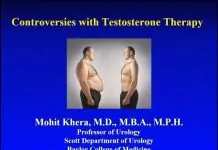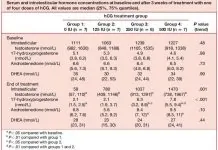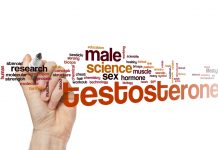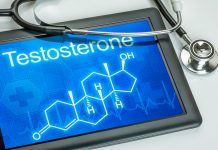Testosterone, HDL and cardiovascular risk in men: the jury is still out
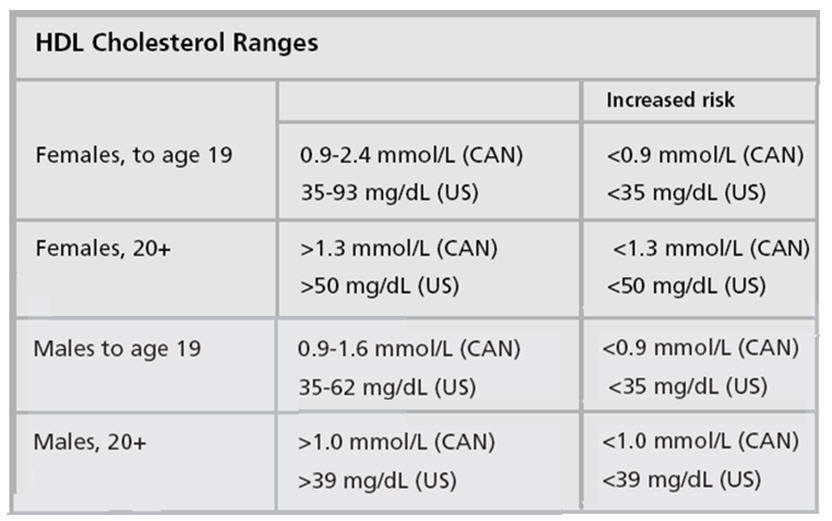
Page, Stephanie T, and Katya B Rubinow. “Testosterone, HDL and cardiovascular risk in men: the jury is still out.” Clinical Lipidology Aug. 2012: 363+. Health Reference Center Academic. Web. 7 July 2015.
Author(s): Katya B Rubinow 1 , Stephanie T Page [*] 2
Testosterone-replacement therapy in older men with aging-associated hypogonadism remains an area of substantial clinical controversy. Although improvements in strength, quality of life and stamina have been observed [1] , reluctance to more broadly prescribe testosterone replacement derives, in part, from concern that replacement therapy may augment cardiovascular risk in men. One basis for this concern is the observation that exogenous testosterone can decrease serum levels of HDL-cholesterol (HDL-C). As low HDL-C is a well recognized risk factor for cardiovascular disease (CVD), this HDL-C-lowering effect could augment risk and therefore argue against widespread use of testosterone-replacement therapy in clinical practice. Importantly, however, the impact of exogenous testosterone on HDL-C levels is not uniform and appears to vary substantially with variables, including patient age and both the dose and route of androgen administration [2] . Thus, the HDL-C-lowering effects of testosterone observed in some clinical or research settings might not be relevant to the use of testosterone for physiologic replacement therapy in older men. Moreover, recent clinical data demonstrate the possible dissociation of HDL-C levels and cardiovascular risk, undermining the assumption that an intervention that reduces HDL-C necessarily translates into augmented risk. Finally, the historical focus on HDL-C alone fails to account for the remarkable complexity of HDL particle composition, particularly with regard to the modifiable protein cargo that likely confers the functional properties of HDL.
Direct evidence for the HDL-C-lowering effect of testosterone derives principally from observations of men using androgenic-anabolic steroids for athletic enhancement [3] . This effect has been achieved consistently with the administration of supraphysiologic doses of oral androgens to young men [2] , but has been far less consistent when testosterone therapy has been used at physiologic doses to restore eugonadal serum levels, particularly in older men [4,5] . Moreover, the lipid-related effects of exogenous testosterone appear highly contingent on whether parenteral or oral routes of administration are employed. Oral testosterone administration significantly reduced HDL-C levels in young, healthy men [6] , whereas when older, hypogonadal men were treated with transdermal testosterone, we found no significant changes in HDL-C after 3 months of therapy [5] . These disparate effects may be a consequence, in part, of first-pass hepatic metabolism that occurs with oral but not parenteral administration. In addition, the HDL-C-lowering effect of testosterone may be offset, at least partially, by aromatase-mediated conversion of testosterone to estradiol, as estradiol can raise HDL-C levels in men [7] , and coadministration of intramuscular testosterone with an aromatase inhibitor led to significant decreases in HDL-C [8] . Increased adiposity and associated aromatase activity in older men could thus play a mitigating role in the androgen-mediated reductions in HDL-C seen in this population. Accordingly, more clinical studies are necessary in order to better define those populations of men at greatest risk of lipid-related effects of testosterone therapy and to determine the testosterone regimens that are least likely to confer seemingly adverse changes in lipid profiles.
Even when reductions in HDL-C are observed as a consequence of androgen therapy, the implications for cardiovascular risk modification remain highly uncertain [2] . Whereas an inverse relationship between HDL-C levels and cardiovascular risk has been demonstrated clearly on a population basis [9] , the utility of HDL-C as a biomarker of individual cardiovascular risk has increasingly fallen into question. Underscoring the limitations of assessing HDL-C alone, recent clinical trials have found no decrease in cardiovascular event rate despite significant and substantial increments in HDL-C after treatment intervention in subjects with pre-existing CVD; indeed, the CETP inhibitor torcetrapib raised HDL-C levels by 72% but was associated with an increased rate of cardiovascular events [10] . Conversely, no long-term data have established that the reduced HDL-C levels observed in men receiving testosterone lead to an increased incidence of CVD. Rather, clinical data strongly suggest that men with low circulating levels of testosterone are at greater risk of CVD [11] . These apparently discrepant findings regarding HDL-C and CVD risk may eventually be resolved as the complexity of HDL biology becomes better understood. Currently, research efforts are expanding to incorporate alternative metrics of HDL composition and function, such that HDL-C content is incorporated into a larger context of particle protein, triglyceride and phospholipid content, as well as quantitative measures of HDL’s pleiotropic functions.
A primary role of HDL-C is that of reverse cholesterol transport, the process whereby HDL particles accept cholesterol from peripheral tissues and transport it to the liver for excretion in bile. These peripheral cholesterol donors include lipid-laden macrophages, which may otherwise deposit cholesterol in the artery wall and contribute to atherogenesis. Rader, Rothblat and colleagues have developed an assay that measures the capacity of serum HDL to efflux cholesterol from macrophages and demonstrated reduced efflux capacity in patients with existing coronary artery disease [12] . Furthermore, investigators found marked interindividual variation in HDL-mediated efflux among subjects with identical HDL-C levels, underscoring the potential dissociation between HDL-C and HDL function [13] . As in vitro data suggest mechanisms by which testosterone could accelerate reverse cholesterol transport [14] , a lower HDL-C level could reflect altered kinetics of cholesterol transport that would actually reduce cardiovascular risk. Thus, these data illustrate the difficulty of drawing inferences about HDL function on the basis of HDL-C alone.
Ongoing research efforts are similarly exploring alternative strategies for assessing the relationship between HDL and CVD, including measurement of HDL particle number and size, determination of HDL protein cargo and assays of other HDL functions [5,15] . For example, our research has generated the novel finding that testosterone replacement in older, hypogonadal men confers changes in the protein composition of HDL particles in the absence of changes in HDL-C [5] . Although we did not observe attendant changes in HDL-cholesterol-efflux capacity, HDL particles also mediate lipid peroxidation, endothelial cell nitric oxide production and immunomodulatory functions [15,16] . The development of new methods to examine the variable composition of HDL therefore promises to offer more nuanced insights into HDL biology overall and, specifically, into the undoubtedly intricate relationships between circulating androgens and HDL composition and function.
In contrast to the historical concern that testosterone might increase cardiovascular risk in men, mounting data now demonstrate elevated risk to be associated with low androgen states [17,18] . This elevated risk is strikingly prominent among men who have undergone androgen-deprivation therapy (ADT) for treatment of prostate cancer, as these men exhibit a two- to three-fold higher incidence of stroke and myocardial infarction, as well as an increased risk of cardiovascular-related mortality after ADT exposures as brief as 6 months [19] . Furthermore, this elevated risk is manifested despite the inconsistent but not infrequent observation of increased HDL-C levels with ADT [19] . However, intervention trials have yielded inconsistent findings. In one study of frail, elderly men, those who received testosterone replacement experienced significantly more cardiovascular events despite gains in mobility and strength [20] . Nonetheless, no increased cardiovascular risk was evident in a similarly designed trial [1] . These conflicting data thus highlight the importance of extending our focus beyond a single HDL-associated metric in order to understand the full scope of testosterone’s effects on HDL and the associated implications for cardiovascular risk. In addition, analogous to the Women’s Health Initiative, large-scale clinical studies in men are needed to help define specific populations of men who are most likely to benefit from replacement therapy and, further, to establish optimal parameters for the timing, dose and duration of testosterone treatment. As yet, however, the role of testosterone in modifying lipoprotein function and cardiovascular risk in men remains highly uncertain and constitutes an intriguing area of emergent research.
References
1 Srinivas-Shankar U, Roberts SA, Connolly MJ et al. Effects of testosterone on muscle strength, physical function, body composition, and quality of life in intermediate-frail and frail elderly men: a randomized, double-blind, placebo-controlled study. J. Clin. Endocrinol. Metab. 95, 639-650 (2010).
2 Shabsigh R, Katz M, Yan G, Makhsida N. Cardiovascular issues in hypogonadism and testosterone therapy. Am. J. Cardiol. 96, M67-M72 (2005).
3 Basaria S. Androgen abuse in athletes: detection and consequences. J. Clin. Endocrinol. Metab. 95, 1533-1543 (2010).
4 Ozata M, Yildirimkaya M, Bulur M et al. Effects of gonadotropin and testosterone treatments on lipoprotein(a), high density lipoprotein particles, and other lipoprotein levels in male hypogonadism. J. Clin. Endocrinol. Metab. 81, 3372-3378 (1996).
5 Rubinow KB, Vaisar T, Tang C et al. Testosterone replacement in hypogonadal men alters the HDL proteome but not HDL cholesterol efflux capacity. J. Lipid Res. 53(7), 1376-1383 (2012).
6 Amory JK, Kalhorn TF, Page ST. Pharmacokinetics and pharmacodynamics of oral testosterone enanthate plus dutasteride for 4 weeks in normal men: implications for male hormonal contraception. J. Androl. 29, 260-271 (2008).
7 Bagatell CJ, Knopp RH, Rivier JE, Bremner WJ. Physiological levels of estradiol stimulate plasma high density lipoprotein 2 cholesterol levels in normal men. J. Clin. Endocrinol. Metab. 78, 855-861 (1994).
8 Friedl KE, Hannan CJ Jr, Jones RE, Plymate SR. High-density lipoprotein cholesterol is not decreased if an aromatizable androgen is administered. Metabolism 39, 69-74 (1990).
9 Boden WE. High-density lipoprotein cholesterol as an independent risk factor in cardiovascular disease: assessing the data from Framingham to the veterans affairs high – density lipoprotein intervention trial. Am. J. Cardiol. 86, 19L-22L (2000).
10 Barter PJ, Caulfield M, Eriksson M et al. Effects of torcetrapib in patients at high risk for coronary events. N. Engl. J. Med. 357, 2109-2122 (2007).
11 Keating NL, O’Malley AJ, Freedland SJ, Smith MR. Diabetes and cardiovascular disease during androgen deprivation therapy: observational study of veterans with prostate cancer. J. Natl Cancer Inst. 102, 39-46 (2010).
12 Khera AV, Cuchel M, de la Llera-Moya M et al. Cholesterol efflux capacity, high-density lipoprotein function, and atherosclerosis. N. Engl. J. Med. 364, 127-135 (2011).
13 de la Llera-Moya M, Drazul-Schrader D, Asztalos BF et al. The ability to promote efflux via ABCA1 determines the capacity of serum specimens with similar high-density lipoprotein cholesterol to remove cholesterol from macrophages. Arterioscler. Thromb. Vasc. Biol. 30, 796-801 (2010).
14 Langer C, Gansz B, Goepfert C et al. Testosterone up-regulates scavenger receptor BI and stimulates cholesterol efflux from macrophages. Biochem. Biophys. Res. Commun. 296, 1051-1057 (2002).
15 Besler C, Heinrich K, Rohrer L et al. Mechanisms underlying adverse effects of HDL on eNOS-activating pathways in patients with coronary artery disease. J. Clin. Invest. 121, 2693-2708 (2011).
16 Gordon SM, Hofmann S, Askew DS, Davidson WS. High density lipoprotein: it’s not just about lipid transport anymore. Trends Endocrinol. Metab. 22, 9-15 (2010).
17 Laughlin GA, Barrett-Connor E, Bergstrom J. Low serum testosterone and mortality in older men. J. Clin. Endocrinol. Metab. 93, 68-75 (2008).
18 Vikan T, Johnsen SH, Schirmer H et al. Endogenous testosterone and the prospective association with carotid atherosclerosis in men: the Tromsø study. Eur. J. Epidemiol. 24, 289-295 (2009).
19 Shahani S, Braga-Basaria M, Basaria S. Androgen deprivation therapy in prostate cancer and metabolic risk for atherosclerosis. J. Clin. Endocrinol. Metab. 93, 2042-2049 (2008).
20 Basaria S, Coviello AD, Travison TG et al. Adverse events associated with testosterone administration. N. Engl. J. Med. 363, 109-122 (2010).




